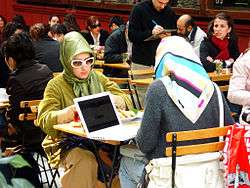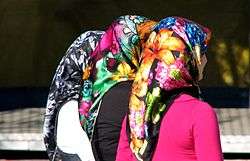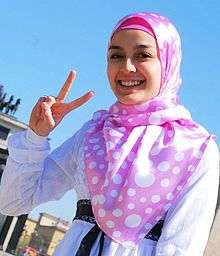Headscarf controversy in Turkey
 |
| This article is part of a series on the politics and government of Turkey |
|
See also
|
Turkey has been a secular state since it was founded by Mustafa Kemal Pasha in 1923. He introduced the secularization of the state in the Turkish Constitution of 1924, alongside Atatürk's Reforms. These were in accordance with the Kemalist Ideology, with a strict appliance of laïcité in the constitution. Atatürk saw headscarves as an obstacle to his campaign to secularize and modernize the new Turkish Republic. The issue of the headscarf debate has been very intense and controversial since its ban, along with other prominent religious symbols, in public buildings such as government institutions and public schools, similar to policies in France and Mexico.[1] Turkey is a secular country and over 95% of its people are Muslims.[2] It has resulted in a clash between those favouring the secular principles of the state, such as the Turkish Armed Forces,[3] who form a minority of the population, and religious conservatives as well as Islamists, who form a majority of the population.

Banning of headscarves
With a constitutional principle of official secularism, the Turkish government has traditionally banned women who wear headscarves from working in the public sector. The ban applies to teachers, lawyers, parliamentarians and others working on state premises. The ban on headscarves in the civil service and educational and political institutions was expanded to cover non-state institutions. Female lawyers and journalists who refused to comply with the ban were expelled from public buildings such as courtrooms and universities.[4]
In the late 1970s and early 1980s, the number of university students wearing headscarves increased substantially and in 1984, the first widespread application of headscarf ban came into effect at the universities, but throughout the 1980s and 1990s, the ban was not uniformly enforced and many students were able to graduate. The headscarf ban in public spaces, including schools and universities (public and private), courts of law, government offices and other official institutions, is only for students, workers and public servants. Hence, mothers of pupils or visitors have no problems at all entering the primary schools, but they would not be able to work as teachers. Similarly, at the courts of law, the ban only involves judges, attorneys, lawyers and other workers. Wearing headscarves in photos on official documents like licenses, passports, and university enrollment documents is also prohibited. Universities and schools refused registering women students unless they submit ID photographs with bared hair and neck.[5]
A regulation in, 16 July 1982 specified that: the clothing and appearances of personnel working at public institutions; the rule that female civil servants' head must be uncovered.
An interpretation of this law in 1997 extended the ban to the wearing of headscarves in all universities in Turkey.[6] The debate over headscarves in universities has been the most contentious of all and has been an important element in the politics of Turkey since 2000.[7]
Workplace
According to Country Reports 2007, women who wore headscarves and their supporters "were disciplined or lost their jobs in the public sector" (US 11 March 2008, Sec. 2.c). Human Rights Watch (HRW) reports that in late 2005, the Administrative Supreme Court ruled that a teacher was not eligible for a promotion in her school because she wore a headscarf outside of work (Jan. 2007). An immigration counsellor at the Embassy of Canada in Ankara stated in 27 April 2005 correspondence with the Research Directorate that public servants are not permitted to wear a headscarf while on duty, but headscarved women may be employed in the private sector. In 12 April 2005 correspondence sent to the Research Directorate, a professor of political science specializing in women's issues in Turkey at Bogazici University in Istanbul indicated that women who wear a headscarf "could possibly be denied employment in private or government sectors." Conversely, some municipalities with a more traditional constituency might attempt to hire specifically those women who wear a headscarf (Professor 12 April 2005). The professor did add, however, that headscarved women generally experience difficulty in obtaining positions as teachers, judges, lawyers, or doctors in the public service (ibid.). More recent or corroborating information on the headscarf ban in the public service could not be found among the sources consulted by the Research Directorate.
The London-based Sunday Times reports that while the ban is officially in place only in the public sphere, many private firms similarly avoid hiring women who wear headscarves (6 May 2007). MERO notes that women who wear headscarves may have more difficulty finding a job or obtaining a desirable wage (Apr. 2008), although this could not be corroborated among the sources consulted by the Research Directorate.
Medical care
According to the Sunday Times, headscarves are banned inside Turkish hospitals, and doctors may not don a headscarf on the job (6 May 2007). Nevertheless, MERO reports that under Turkey's current administration, seen by secularists to have a hidden religious agenda (The New York Times 19 February 2008; Washington Post 26 February 2008), doctors in some public hospitals have entered the premises wearing headscarves (MERO Apr. 2008).
The professor of political science at Bogazici University in Turkey stated that, in addition to never having come across any cases where women wearing headscarves had been denied access to medical care in private or public medical centres, he felt it would be unlikely that this would occur (12 April 2005). The Immigration Counsellor at the Embassy of Canada in Ankara stated that "women who wear headscarves have full access to medical care" (27 April 2005), though news reports [8] and NGO reports to the UN[9] confirm that "women wearing the headscarf have been denied medical care in Turkish hospitals."[9]
Controversial events

- In 1968, a female public university student, Hatice Babacan, refused to remove her headscarf in university buildings.
- In 1998, a Turkish student was banned for wearing a headscarf at Istanbul University.[10]
- In 2000, Nuray Bezirgan, a Turkish female student, wore a headscarf at her college final exams. A Turkish court sentenced her to six months jail for "obstructing the education of others".[10] The European Court of Human Rights upheld the ban in 2004, finding that the law did not violate the European Convention on Human Rights.[10] In October 2006, the European Court of Human Rights upheld the university ban again, rejecting a complaint filed by another Turkish university student.[11]
- In May 1999, the ban on headscarves in the public sphere hit the headlines when Merve Kavakçı was prevented from taking her oath in the National Assembly because she wore a headscarf. She was the newly elected-MP of Istanbul of the pro-Islamist Virtue Party, and she refused demands to leave the building. The secular opposition members protested by chanting 'out' for 30 minutes, and the then prime minister Bülent Ecevit accused her of violating the principles of secularism.[12] A state prosecutor investigated whether she might be put on trial for provoking religious hatred.[13] She received much support from Iran, by the Ayatollah Ahmad Jannati and hundreds of women demonstrating in support of the deputy.[14] A few months later her Turkish citizenship was revoked because she also held an American citizenship.[15]
- In October 2006, Turkish president Ahmet Necdet Sezer refused to allow AKP politicians whose wives wore headscarves to a ball marking Turkish independence, saying it would compromise and undermine the separation of mosque and state in Turkey.[16]
- In March 2009, Kıymet Özgür who wore the çarşaf (chador) was attacked by CHP members when she tried to get into an election bus of mayoral candidate Kemal Kılıçdaroğlu in Istanbul. It was later reported that she had disguised herself to test the party's new initiative.[17]
- CHP (Republican People's Party) leader Deniz Baykal surprised supporters by allowing those who wear the çarşaf (chador) to become members of the party in late 2008. The surprising move was viewed as a strategy to attract conservative voters to the party.[18] Some criticised Baykal's move as an attempt to move the party towards the right.[19]
Attempts at lifting ban
Prime Minister Erdoğan campaigned in his victorious 2007 campaign with a promise of lifting the longstanding ban on headscarves in public institutions. However, as the Turkish deputies voted in Parliament, tens of thousands protested outside in favour of the ban.[20]
On February 7, 2008, the Turkish Parliament passed an amendment to the constitution, allowing women to wear the headscarf in Turkish universities, arguing that many women would not seek an education if they could not wear the head scarf. The main political party, the Justice and Development Party and a key opposition party, the Nationalist Movement Party claimed that it was an issue of human rights and freedoms.[21][22][23][24] The Parliament voted 403-107 (a majority of 79 per cent) in favour of the first amendment, which was inserted into the constitution stating that everyone has the right to equal treatment from state institutions. However the move resulted in opposition throughout Turkey. The country's educational board and numerous universities vowed to defy the new law. In addition, the main pro-secular, opposition party of the Republican People's Party asked the constitutional court to block the new law passed, and viewed it is a move towards an Islamic state.[25] Thousands of demonstrators supporting the ban also gathered near the Parliament against the move by the government.[26]
Lifting of ban annulled
On 5 June 2008, Turkey's Constitutional Court annulled the parliament's proposed amendment intended to lift the headscarf ban, ruling that removing the ban was against the founding principles of the constitution. The highest court's decision to uphold the headscarf ban cannot be appealed (AP 7 June 2008).[27]
See also
- Leyla Şahin v. Turkey
- Islamic dress in Europe
- Islam and clothing
- Islam in Turkey
- Secularism in Turkey
- Freedom of religion in Turkey
- Merve Kavakçı
- Snow (Pamuk novel)
References
- ↑ BBC - BBC News - In Depth - Turkey: Battle of the headscarf - By Roger Hardy (Islamic affairs analyst)
- ↑ CIA World Factbook - Turkey - People (Religion)
- ↑ "Turkey's Mrs Gul given makeover". BBC News. August 2007. Retrieved 2009-04-13.
- ↑ Turkey: Situation of women who wear headscarves, UNHCR
- ↑ THE RISE OF THE ISLAMIST MOVEMENT IN TURKEY
- ↑ Turkey eases ban on headscarves
- ↑ Turkey divided over headscarf ban
- ↑ http://www.zaman.com.tr/haber.do?haberno=900669&title=ninesi-yasindaki-hastayi-basortulu-diye-muayene-etmedi
- 1 2 http://lib.ohchr.org/HRBodies/UPR/Documents/Session8/TR/BFRL_UPR_TUR_S08_2010_BecketFundforReligiousLiberty.pdf
- 1 2 3 Singh, K. Gajendra. Ban on headscarves and Turkey. Turkish Daily News. 2004-09-21.
- ↑ Strasbourg court's ruling upholds headscarf ban. Turkish Daily News. 2006-10-17.
- ↑ Headscarf row in Turkey parliament BBC News. May 3, 1999.
- ↑ Headscarf deputy stands ground BBC News. May 3, 1999.
- ↑ Ayatollah attacks 'hypocritical' Turkey BBC News. May 14, 1999.
- ↑ Citizenship twist in headscarf row BBC News. May 12, 1999.
- ↑ Turkey in veil controversy. Asia News. 2006-10-30.
- ↑ CHP members’ attack on chador-wearing woman suspicious Today's Zaman.
- ↑ Baykal’s unyielding support for chador move greeted warmly Today's Zaman.
- ↑ Baykal under attack Hurriyet.
- ↑ Jones, Dorian. "Turkey's Parliament Eases Ban on Islamic Head Scarves at Universities". VOA. Retrieved 2009-04-13.
- ↑ Ayman, Zehra; Knickmeyer, Ellen. Ban on Head Scarves Voted Out in Turkey: Parliament Lifts 80-Year-Old Restriction on University Attire. The Washington Post. 2008-02-10. Page A17.
- ↑ Derakhshandeh, Mehran. Just a headscarf? Tehran Times. Mehr News Agency. 2008-02-16.
- ↑ Jenkins, Gareth. Turkey's Constitutional Changes: Much Ado About Nothing? Eurasia Daily Monitor. The Jamestown Foundation. 2008-02-11.
- ↑ Turkish president approves amendment lifting headscarf ban. The Times of India. 2008-02-23.
- ↑ O'Toole, Pam (2008-02-27). "Turkish appeal against scarf law". BBC News. Retrieved 2009-04-13.
- ↑ Gulfnews - Turkey votes to lift headscarf ban
- ↑ BBC - BBC News - Court annuls Turkish scarf reform
